30 March 2018

Introduction
At the end of 2017, the economic momentum in the European Union (EU) continued with positive GDP growth, falling unemployment rates and expanding private consumption. In an environment of improving economic fundamentals, coupled with generally very low interest rates, the overall mortgage market in the EU is expanding, notwithstanding the overall challenging geopolitical international and domestic tensions. Almost across the board house prices are stable/increasing year-on-year (y-o-y) and, in some jurisdictions, they are increasing by double-digits, while in others there are clear signs of a shift towards a deceleration in house prices. In this generally positive market outlook, a growing number of countries are considering the introduction of or have already introduced macroprudential recommendations to cool-off the more heated market segments, either by introducing more stringent LTV caps or by imposing amortisation schemes for certain types of mortgage contracts. The widespread imbalance between demand and supply, especially in the high-growth areas of the continent, is likely to persist over the coming quarters, although construction figures are picking up. Of course, national heterogeneities are still present and these must be analysed in more depth.
Mortgage Market – market developments
In our EU sample[1] the outstanding market continued its positive path concluding 2017 with a 2.0% increase with respect to the same period of last year (year-on-year, y-o-y) and with a 0.44% increase with respect to the previous quarter (quarter-on-quarter, q-o-q). Regarding new lending, the figures showed, on aggregate, a slight inflection to EUR 276 bn, marking respectively 0.3% q-o-q and 1.4% y-o-y decrease. In general, this stable evolution can be explained by the above-mentioned factors which encourage borrowers to climb up or take the first step onto the housing ladder. The national particularities are described in more detail in this section following the geographic macro-areas of the continent.
The country with the most important increase in outstanding mortgage market is France, with a more than 6% y-o-y expansion. Notwithstanding this fact, demand has shown signs of weakness and the gross lending volume contracted by over 15% over the same period, and by 13% in terms of number of loans. A similar picture can also be seen in Belgium, where outstanding mortgages increased, while gross lending figures showed noticeable variations in all mortgage categories. Moreover, refinancing deals also decreased significantly by 60% y-o-y. However, despite a weak fourth quarter, 2017 overall saw an all-time record in terms of credits granted.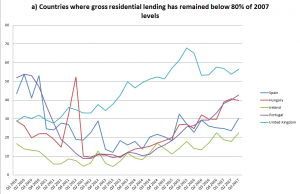
In Central and Eastern Europe, the picture is mixed. In countries like Germany both outstanding and gross lending show a stable y-o-y expansion of both gross and outstanding lending, and also in the Czech Republic the improving macroeconomic fundamentals support an expanding mortgage market, although gross lending in the last quarter of 2017 contracted by 4.6% with respect to the same period in 2016. In Poland, at the end of 2017 fewer but larger mortgages were granted. Here the number of new loans decreased by 2% but the average amount increased by 2% q-o-q. This inflection in the numbers for the second quarter in a row can be explained by the increase of alternative funds used by home-buyers, as currently more than 60% of the apartments bought in the largest cities are acquired by own funds. In Hungary, the increase in housing mortgage loans offset by the decreasing home equity loans resulted in a constant volume of outstanding residential mortgage loans over the second half of 2017. Looking at the number of mortgages disbursed the last quarter of 2017, this was roughly in line with the previous quarter, but it grew by 45% y-o-y. Romania continued a positive evolution of both gross and outstanding mortgage loan figures with very low NPL figures of 3.2% in the reference quarter.
Moving south, in Italy the market confirmed its positive trend with outstanding mortgage loans increasing by 2.0% y-o-y and gross figures by 15% q-o-q. New loans, however, marked a 25% decrease y-o-y. The positive evolution over the last quarter was demand-driven and sustained by improved consumer confidence. Similarly, on the Iberic peninsula, new loans continue to depict a positive trend. In Q4 2017 in Spain gross figures marked a 13% y-o-y increase with re-mortgaging accounting for 5.0%, less than half the amount seen in the last quarter in 2016. In aggregate terms, 2017 depicted the largest amount of new lending for the last seven years, thus consolidating a recovery supported by both improving economic figures and accommodative monetary policy. In Portugal the mortgage market continues the positive of new loans which started in spring 2013 and depicts a 42.7% y-o-y growth in Q4 2017, approaching 2011 levels but still far away from the pre-crisis levels. The increase in new loans shows a decelerating trend, mostly due to the lack of new listings; however, it is expected that the upswing in the real estate market, coupled with a greater competition among banks, may decrease credit standards for new loans.
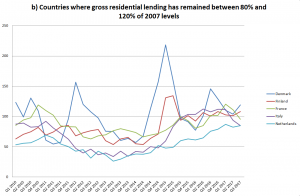
Moving north, in Denmark, gross mortgage lending contracted by 5.4% y-o-y while it increased by 10% q-o-q, due to the increase in both floating and fixed rate loans. Outstanding mortgages increased as well by 2.1% y-o-y. In Finland, the improved economic conditions saw and increase of housing loan drawdowns of 1.0% and of outstanding mortgages of 2.2% compared to Q4 2016. In Sweden, net mortgages are still relatively high with a 7% increase in 2017, but it has marked a significant deceleration with respect to the previous years. Here too this significant increase can be explained by positive market fundamentals coupled with good access to credit and rapid urbanisation. Rent control makes the market dysfunctional and exacerbates house price growth, especially in the larger cities.
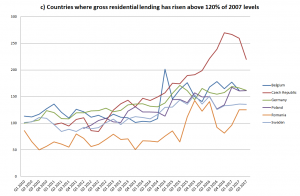 In the UK, the economy is providing mixed signals with high inflation, mediocre GDP growth and low, though increasing, unemployment figures. The housing market shows some resilience with first-time-buyers (FTBs) showing the greatest numbers since before the crisis 11 years ago, also due to the range of government support. Other home-owners who do not benefit from any support remain at depressed levels, barely half the numbers seen in the mid-2000s. Buy-to-let (BTL) loans fell sharply over the early part of 2016 and now appear to have stabilised at a much lower level than in previous years due to a different regulatory and fiscal environment. Re-mortgaging, an area of strength beginning 2017, fell away in terms of both home-owners and BTL over the last quarter in 2017. It is expected that there may be an upswing in the near future whilst interest rates are still low and borrowers find it attractive to lock into more fixed-rate deals. In Ireland, the housing market showed a great dynamism in 2017 with an increase in housing completions of 29%, housing starts of 33%, housing sales of 9.4% and transactions by 8% on a y-o-y basis. Non-household buyers play an important role in the market, accounting for 26% of the purchase of new properties and 13.4% of second hand residential properties. Mortgages as well showed an 18% increase in volume terms and 29% increase in value terms. Mortgage approval activity also significantly increased by around 23% in volume and 34% in value terms in 2017.
In the UK, the economy is providing mixed signals with high inflation, mediocre GDP growth and low, though increasing, unemployment figures. The housing market shows some resilience with first-time-buyers (FTBs) showing the greatest numbers since before the crisis 11 years ago, also due to the range of government support. Other home-owners who do not benefit from any support remain at depressed levels, barely half the numbers seen in the mid-2000s. Buy-to-let (BTL) loans fell sharply over the early part of 2016 and now appear to have stabilised at a much lower level than in previous years due to a different regulatory and fiscal environment. Re-mortgaging, an area of strength beginning 2017, fell away in terms of both home-owners and BTL over the last quarter in 2017. It is expected that there may be an upswing in the near future whilst interest rates are still low and borrowers find it attractive to lock into more fixed-rate deals. In Ireland, the housing market showed a great dynamism in 2017 with an increase in housing completions of 29%, housing starts of 33%, housing sales of 9.4% and transactions by 8% on a y-o-y basis. Non-household buyers play an important role in the market, accounting for 26% of the purchase of new properties and 13.4% of second hand residential properties. Mortgages as well showed an 18% increase in volume terms and 29% increase in value terms. Mortgage approval activity also significantly increased by around 23% in volume and 34% in value terms in 2017.
Mortgage Market – Regulation & Government Intervention
As a new section in the Quarterly Review, here the reader will find more detailed information regarding the actions of the relevant public authorities to cool-down markets or to support some specific market categories. Recognising the wealth of ongoing measures, this section focuses exclusively on actions which have either been announced or introduced in Q4 2017 to provide a sense of the current action in this regard.
On the Regulation side, the activities registered in the reference quarter are split between support schemes for certain categories and macroprudential intervention to cool-off the market.
In countries like Spain, Ireland and France, the demand of the new housing market was supported by public incentives. In order to promote the home rental market in Spain the government has approved a new State Housing Plan for 2018-2021 which seeks to facilitate access to housing for vulnerable groups and tries to boost the regeneration of urban and rural areas affected by depopulation. These aids will be retroactive starting from 1 January 2018. Similarly, in Ireland in 2017 the government’s Help-to-Buy scheme which offers tax refunds for four years to FTB on purchasing and building new homes has supported 52% of total purchases of new property, while in France there are supporting schemes targeted at FTBs and investors.
In Poland there have been changes in personal and corporate tax law covering property rental taxation or the introduction of a new tax on commercial real estate. Moreover, less restriction on minimal usable floor space and a reduction of the minimum size of an individual room has been abolished, thus providing more flexibility to the market.
On the other side, France announced its new “housing strategy” for 2018, with drastic cuts to some incentives such as zero-rate loans and housing grants, which should be voted into law in early 2018. In the Czech Republic the central bank has increased the base interest rates to 0.5% in Q4 2017 and is expected to provide further hikes in 2018. The central bank has also decided to increase the countercyclical capital buffer to 1.25% in 2019. Moreover, in Poland the Minister of Development and Finance decided to raise the risk weight for exposures secured by mortgages on real estate for FX housing loans to 150%. In addition, the Minister also introduced a decree on the waiver of income tax on certain incomes related to a mortgage loan granted for housing purposes. In Sweden the topic is also heavily debated and stricter amortisation requirements for high Loan-to-Income borrowers are going to enter into force in March 2018. In the UK, the Prudential Regulation Authority’s requirements on BTL mortgages came into full effect at the start of Q4 2017, requiring lenders to operate additional, stronger affordability tests for “portfolio landlords” with four or more BTL properties, to mitigate against perceived higher default risk amongst this cohort of investors. Likewise, in Belgium, in the light of increasing household indebtedness in November 2017 the central bank announced the introduction of additional macroprudential measures to limit these risks. The new measure consists of two components: the first is a measure that already came into effect in 2013 and expired in May 2017 (but was continued voluntarily by the banks), and is applied equally to all loans. This linear component consists of an increase of five percentage points of the risk weight calculated on the basis of internal models. The second, more focused component, would be applied on the basis of the average risk of each bank’s portfolio, using a coefficient (multiplier). In that case, the (micro-prudential) initial risk weight would be multiplied by 1.33. That way, a relatively higher capital requirement would be imposed on banks with a riskier portfolio of mortgage loans, thus contributing more to systemic risk. The new measure will enter into force by the end of April 2018.
In the other countries, no specific actions were reported for Q4 2017, but in several countries there are discussions on introducing or improving measures such as the loan-to-income cap and maximum maturity for housing loans.
House Prices
In various countries, the latest data available on house prices show a generally ongoing increasing trend due to the well-known supply and demand imbalances, but in some cases the dynamics shifts to a slower or stagnating pace. 10 out of 16 of countries of our sample depict an increase of more than 5% y-o-y with four more greater than 10% y-o-y, while only two were below 2% y-o-y. At a q-o-q level, a cyclicality in the index can be detected over the year with generally a slight decrease in house price growth in the last quarter. In 2017, the last quarter slowed to a 1.0% q-o-q increase compared to a 1.5% q-o-q increase in Q3 2017, but was slightly higher with respect to Q4 2016.
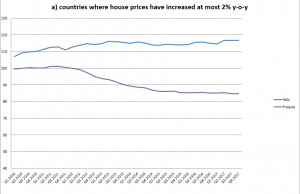 In Central Europe, in the Czech Republic house prices increased by over 13% y-o-y and vacancy rates are at their historical low. In Germany too, prices continue their upwards path, especially in the light of the low interest environment. Although the purchase prices seem to be very high, many market participants still consider home ownership to be a sound investment. In Poland the major cities, especially on the secondary market, show a sustained growth of between 4.4% and 5.3%, while in the capital city prices were more stable. In Hungary house prices showed a positive trend as well in Q3 2017, the last available figure, but it is expected than in the upcoming months the rate will decrease.
In Central Europe, in the Czech Republic house prices increased by over 13% y-o-y and vacancy rates are at their historical low. In Germany too, prices continue their upwards path, especially in the light of the low interest environment. Although the purchase prices seem to be very high, many market participants still consider home ownership to be a sound investment. In Poland the major cities, especially on the secondary market, show a sustained growth of between 4.4% and 5.3%, while in the capital city prices were more stable. In Hungary house prices showed a positive trend as well in Q3 2017, the last available figure, but it is expected than in the upcoming months the rate will decrease.
Italy is the sole major country in which at a national level and on average house prices slightly contracted. This trend was directly related to the reduction of existing dwellings by 0.7% compared to the previous quarter and by 1.3% with respect to the same quarter of the previous year. In the reference quarter a Bank of Italy survey showed that the share of real estate agents that reported downward pressures on house prices increased again. Moving to the Iberic Peninsula, in Portugal 2017 concluded with a quarter of 10.5% y-o-y growth, while in Lisbon the price increase more than doubled to an impressive rate of 21.1% over the same period. This trend is expected to be maintained considering the lack of supply. Similarly, in Spain new housing increased by 2.3% y-o-y while existing ones by 3.1% y-o-y.
Moving to France, house prices of all categories kept on growing throughout 2017 with the country growing at 5%, while Paris grew at 8.6% and the average price for an apartment over the year in the country increased by nearly 6% to c. EUR 270,000. In Belgium, house prices are also generally increasing although the levels among different regions vary greatly. In Wallonia an average apartment costs c. EUR 172,000, in Flanders and in Brussels they are respectively over EUR 220,000 or EUR 234,000. In the Netherlands house prices increased by a healthy 8.1% y-o-y in Q4 2017.
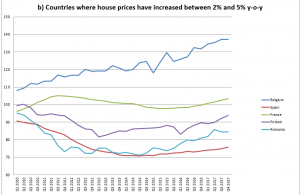 Moving north, in Denmark prices increased at different paces. Single family houses increased by a marginal 0.2% q-o-q, while owner occupied apartments saw a 0.3% drop, the first since Q1 2014. Single family houses on the other hand appreciated by 5.3% over the past year and owner-occupied apartments increased by 8.5%. This rise is primarily driven by the increase in price of these house categories, especially in the first half of the year. The calmer Q4 2017 can be explained by the seasonal patterns. In Finland, prices continued to remain stable due to the supply matching the demand. However, there are spatial differentiations due to urbanisation and immigration. In Sweden single family homes increased by 8.0% y-o-y while apartment fell by 3.0% over the same period after a 7.0% increase in Q3 2017. From October 2017 onwards there has been a quick shift in price developments and the expectation of future price increases. Prices on single family homes decreased by 1.0% in February 2018 y-o-y and apartments decreased by nearly 8.0%. In Stockholm prices contracted by 10% during the same period of time.
Moving north, in Denmark prices increased at different paces. Single family houses increased by a marginal 0.2% q-o-q, while owner occupied apartments saw a 0.3% drop, the first since Q1 2014. Single family houses on the other hand appreciated by 5.3% over the past year and owner-occupied apartments increased by 8.5%. This rise is primarily driven by the increase in price of these house categories, especially in the first half of the year. The calmer Q4 2017 can be explained by the seasonal patterns. In Finland, prices continued to remain stable due to the supply matching the demand. However, there are spatial differentiations due to urbanisation and immigration. In Sweden single family homes increased by 8.0% y-o-y while apartment fell by 3.0% over the same period after a 7.0% increase in Q3 2017. From October 2017 onwards there has been a quick shift in price developments and the expectation of future price increases. Prices on single family homes decreased by 1.0% in February 2018 y-o-y and apartments decreased by nearly 8.0%. In Stockholm prices contracted by 10% during the same period of time.
In Ireland, residential property prices increased by 12.3% y-o-y in December 2017 marking an ongoing acceleration over the last six quarters. Dublin increased by 11.6% and the rest of the country by 13.3%. While transaction volumes are relatively low, apartment prices rose significantly faster than house prices, 14.3% compared to 11.9%. In the UK, overall house prices continued to increase in Q4 2017, though at a decelerating pace and there are also some decreasing monthly figures. Whilst a sustained negative period is not anticipated, further negative shocks, to employment or elsewhere in the economy, may increase this probability of further negative numbers.
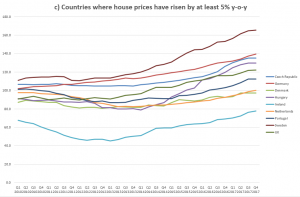
Mortgage Interest Rates
In our sample, in aggregate terms, the average interest rate virtually did not change with respect to the previous quarter. In Q4 2017 it remained around 2.23%, marking an imperceptible increase with respect to previous quarter. Interest rates across the continent remained low following the overall low reference rates of the central banks and fixed interest rate types are increasing their overall market share as borrowers seek to be locked-in to the more favourable low interest rate environment. However, the dispersion of interest rates of the various jurisdictions has been picking up for the last two quarters, reaching the same levels as Q1 2016.
In Central Europe in the Czech Republic the average interest rate increased to 2.2% in Q4 2017 following the increase of the interest rate of the national bank and future hikes are expected, thus triggering also future increases in the mortgage rates. In Hungary the most popular mortgage instrument is the variable rate following the Budapest interbank rate (BUBOR). This is, however, decreasing due to the lower spread of the more fixed rate, which customers find more appealing for the decreased volatility attached to it. In Poland interest rates remained unchanged, though inflationary pressures are growing. However, no interest rate increases are planned for the near future. In Romania in Q4 2017 the average interest rate increased to 4.42%, thus decreasing the drawdowns of mortgages with a variable interest rate at the expense of more fixed rates.
In Italy variable interest rate loans continued to decrease to 1.53% while those with a fixed period of more than one year remained around 2.12%. In Portugal variable mortgage rates have a component linked to the EURIBOR which has reached historically low levels contributing to increasing gross lending and reducing household debt. Here, as in Spain, the low interest rate environment convinced more and more mortgage holders to opt for a more fixed interest rate solution. In Belgium the interest rate marked extremely low average levels of 2.03% in Q4 2017.
In Denmark all mortgage classes except the variable loan with rate fixation from five to 10 years had an interest rate decrease. For a short period of time at the end of Q4 2017, households could lock in mortgage rates of 1.5% for 30 years. The trend of moving into a more fixed interest rate terrain has been decreasing as the low interest rates have been persistent for a while now and those changes have already been made. There may be, however, a further push in this direction in the coming years as new and tighter lending standards come into force in 2018. In Finland interest rates reached a record low of 0.95%, while in Sweden the situation in Q4 2017 remained relatively stable with interest rates with a fixation period of over five years around 2%, variable mortgage rates increased slightly to 1.5% while the medium fixed rates remained around 1.7%.
In Ireland variable rates, accounting for 43% of new mortgages issued in Q4 2017, marked the absolute low of this data series, which started in Q1 2003. According to the Central Bank of Ireland, the share of fixed-rate mortgages (57%) was still lower than the Euro area average of 80%. Some 42% of outstanding mortgages, excluding securitised loans, were on ECB base rate-linked tracker mortgage rates in Q4 2017. The average interest rate on these mortgages was 1.04% for owner-occupier mortgages and 1.05% for buy-to-let mortgages. Despite the start of the upswing in the interest rate cycle, mortgage interest rates remain at attractive levels, and this will continue to provide plenty of incentive for re-mortgaging activity in the coming months.